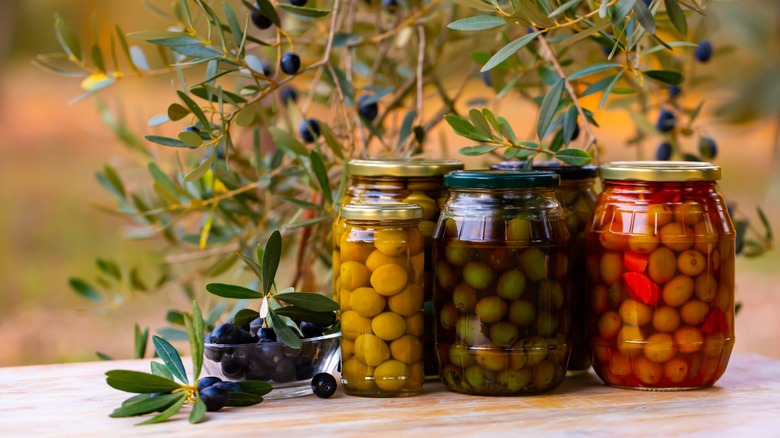What To Know Before Trying To Freeze Those Leftover Olives
Olives are an irresistible snack that's a staple for many a home bar, charcuterie board, or hors d'oeuvre table. And with a multitude of olive varieties to choose from, it's not always easy to finish every jar, even for the biggest olive lovers among us. Even though an opened jar of olives can last quite a while in the refrigerator, sometimes you want to ensure your olives stay at peak freshness for as long as possible. The best way to do this is to freeze them. But freezing olives isn't as simple as stuffing them into a freezer bag and tossing them to somewhere in the freezer. Because they've been stored in a salty brine, you'll need to take a few pre-steps first.
The one step you don't want to skip is rinsing and draining your olives before freezing. Even though you'd regret draining your can of olives for shelf-stable storage, it's imperative to do so when freezing them. However, your preparation method is determined by the kind of olives you're planning to freeze, and how they were cured.
The best olives for freezing
Olives are typically cured in salt, a mix of water and lye, in brine, or by drying then soaked in oil. If you're freezing olives that have been cured with lye — typically green olives – you'll need to boil them in their brine for up to 15 minutes before rinsing in cold water and draining them. You don't want any lye to freeze with the olives, as the lye will soften them while in the freezer. Black olives, such as Kalamata and mission olives, are often cured in brine and stored in oil. Because the oil can also make the olives mushy in the freezer, these olives should be rinsed and drained as well. On the other hand, olives that have been dry salt-cured can head straight to the freezer, as there is no brine, lye, or oil to rinse off.
If you've grabbed olives from a salad bar or deli, it's best to enjoy them right away. Salad-bar olives are often taken out of their original storage jars and drained before being served in a marinade, making them more likely to soften if you freeze them, compared to dry salt- or lye-cured olives.
No matter which kind of olives you freeze, you must make sure to properly package them before freezing. An airtight container or freezer bag works best. Don't fill the bag or container to the top, however, as the olives need space to expand when they freeze.
Thawing and serving your olives after freezing
So once you've properly frozen and stored your olives, what's the best way to prepare them for serving again? Whether you're thawing a small or large batch of frozen olives, your best bet is to defrost them in the refrigerator. Quick thawing methods like defrosting in the microwave won't help the olives maintain their texture like defrosting in the refrigerator will. While the olives will last for up to six months, it's best to enjoy them within three months for the closest-to-fresh quality.
Once they're fully thawed, you're free to enjoy the olives as they are. But if you'd like to amp up the flavor, you can create a delicious marinade for your thawed olives to soak in before serving. Think of it as recreating the flavorful brine they were stored in when you originally purchased them. You could use your olives to make a tapenade, or serve the olives in warm oil for a luxurious snack. As long as you rinse and drain your olives before freezing, delicious olives will be ready for any future snacking endeavors.


